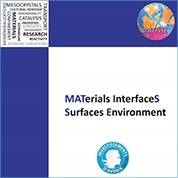Scientific Axes
AXE 1 - Biomineralization
Life sciences and materials: the best of both worlds
Mutual interactions between inorganic materials and the living world, from biomolecules to full ecosystems, constitute a fascinating area. Several teams of the Labex have studied this topic in the context of the biogeochemical cycle of carbon, prebiotic chemistry (origins of life) and biomineralization processes, both in natural environment (influence of organisms of the properties of minerals formed in their presence) and as a source of inspiration for the design of novel materials (biomimetism).
We will put together most advanced experimental and analytical resources available in the laboratories of the Labex partners to: (i) elucidate the structure-function relationships in biominerals, (ii) develop novel elaboration routes in dynamic and structured environments, (iii) explore the information transfer between the biological world and the field of inorganic chemistry. This topic will mainly involved the following teams: LRS, LCMCP, IMPMC, METIS, LG-ENS, PHENIX.
AXE 2: Multi-functional materials and environment
Original strategies with improved environmental concerns for the design of functional materials
Axis 2 is focused on the development of materials with targeted properties based on nano-structuration and/or a controlled surface reactivity. Some exist, others have yet to be invented using nature as a model. Priority is given to synthetic processes based on "soft" chemistry, "green" chemistry and / or self-assembly. Modification and shaping are also of great concern in order to control the behaviour of the resulting materials in various environments. Four sub-themes have been defined: i) Bio‐inspired synthesis strategies, ii) New biosensors, iii) Tailoring surfaces and iv) Green catalysts with improved performances. Main application areas are in the fields of health (with the development of biosensors and biocompatible materials), environment (with the development of "green" catalytic processes) and energy (photovoltaic devices).
This topic will mainly involve the following teams: LCMCP, LRS, INSP, LISE and RF@IFP-EN.
AXE 3 - Diffusion and surface reactivity: from molecular scale to kilometer
The mechanisms involved at the molecular level and located at the solid-solution interface, combined with transport and diffusion processes in porous media, can impact a large number of environmental and technological processes. These include alteration or rehabilitation of materials, phase transformation process or reactivity of interfaces. All Matisse teams present a set of recognized skills and technical know-how, for example by controlling advanced experimental methods to meet the future challenges in different areas such as heritage, energy, health, environment. This theme will involve the following Matisse teams LG-ENS, ISTEP, IMPMC, LCMCP, LRS, LISE, PHENIX, PASTEUR, CRCC, LRMF, C2RMF, IFP-EN…
AXE 4 - Dimensionality and confinement
To be completed
AXE 5- Materials under extreme conditions
From the study of the nature and structure of deep Earth and planetary interiors to the synthesis of new materials (ultra hard materials or superconductors), this axe puts together unique experimental skills in high pressure and high temperature research with the most advanced theoretical methods to characterize and predict new structures and properties of materials under extreme conditions. This theme gather a large number of MATISSE laboratories:with complementary competences in chemistry, material science, physics and geoscience to develop a multi-disciplinary approach to unravel the mechanisms for materials transformations and synthesis under the new chemical and physical constrains dictated by the extreme conditions.
The four main topics of the axis are:
- In-lab characterization of deep earth and planetary interiors.
- New physical and chemical properties of materials under high pressure.
- Synthesis of new materials (ultra hard materials or superconductors) through high‐pressure out‐of‐ equilibrium thermodynamic routes.
- Characterization of metastable materials: from glass transition to out of equilibrium systems
Members: CAC, C2RMF, LG-ENS, IMPMC, LCMCP, LPTMC, ISTEP, LMCM, PECSA.
AXE 6 -Theory and Modeling in Computational Material Science
Computer modeling of materials has a central role for the Labex. Indeed, the capability of calculating with high accuracy material properties opens the way to use computer modeling to design new materials, to predict material behavior under particular environmental conditions before or in absence of experimental investigations, as well as to get a physical insights and disentangle distinct effects in the experimental data. In order to meet those objectives, the simulation approaches should be accurate and cover different length and time scales. Another goal is the direct modeling of the advanced experimental probes that are used by other partners within the Labex. To cope with such needs new and original methods should be developed. This is the main role of this axes. The new methods should not restricted to a particular subject but should cover several domains in the Labex, thus giving the theoretical axes a peculiar transverse character that (1) reinforces its theoretical flavor and (2) opens up new perspectives for collaborations with experimental partners in other axes.
In this section
Key figures
MATISSE :
4 disciplines
- Chemistry
- Physics
- Earth Science
- Cultural heritage
18 partners
400 researchers
Contact
Direction :
Florence Babonneau
Administration :
Laurence Bonnet-Lericque
Communication :
Tél. (33) 1 44 27 62 36




